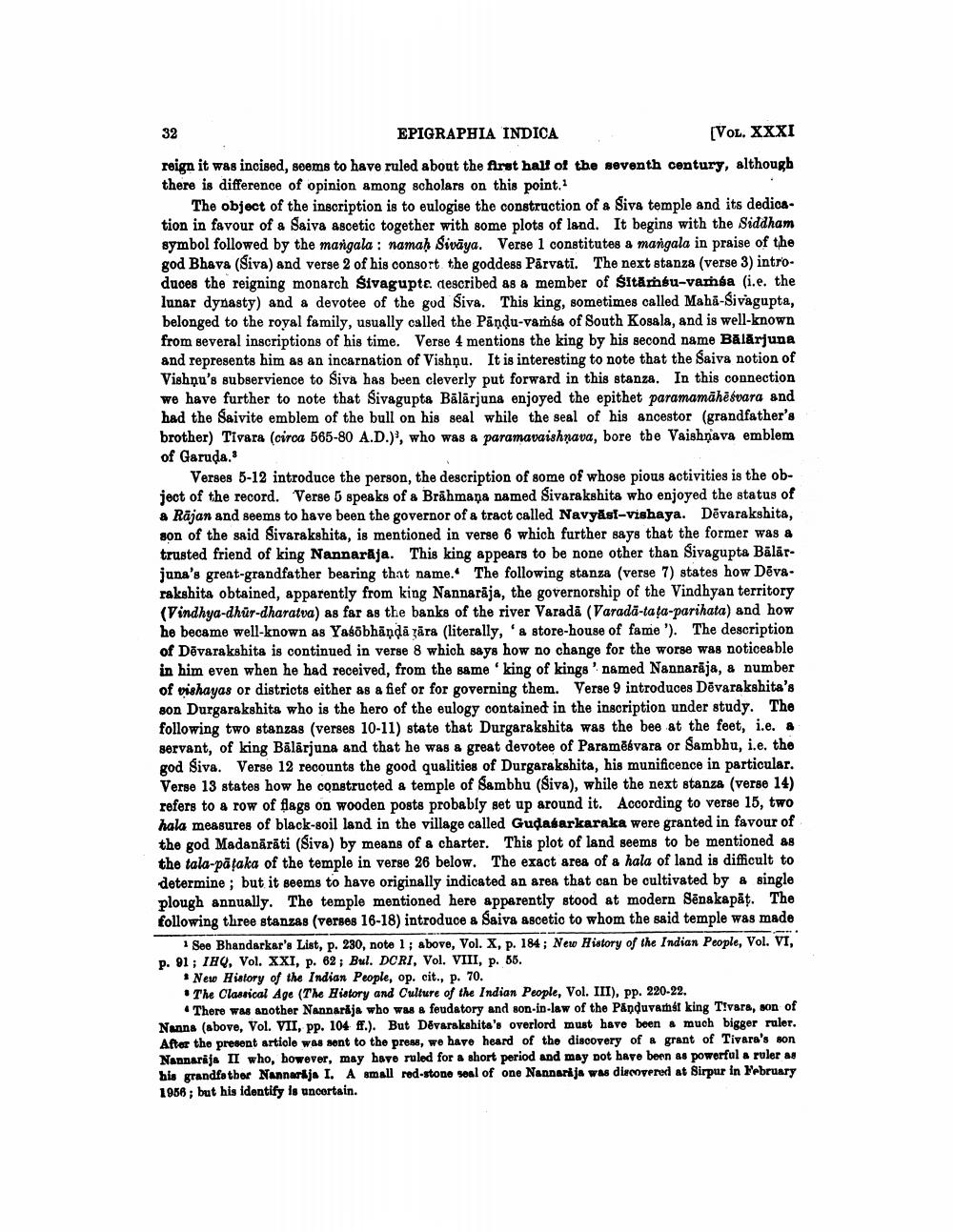________________
32
EPIGRAPHIA INDICA
[Vol. XXXI reign it was incised, seems to have ruled about the first half of the seventh century, although there is difference of opinion among scholars on this point,
The object of the inscription is to eulogise the construction of a Siva temple and its dedication in favour of a Saiva ascetic together with some plots of land. It begins with the Siddham symbol followed by the mangala : namah Sivāya. Verse 1 constitutes a mangala in praise of the god Bhava (Siva) and verse 2 of his consort the goddess Parvati. The next stanza (verse 3) introduces the reigning monarch Sivagupte described as a member of sitāmgu-vamsa (i.e. the lunar dynasty) and a devotee of the god Siva. This king, sometimes called Maha-Sivagupta, belonged to the royal family, usually called the Pāņdu-vamsa of South Kosala, and is well-known from several inscriptions of his time. Verse 4 mentions the king by his second name Bālārjuna and represents him as an incarnation of Vishnu. It is interesting to note that the Saiva notion of Vishnu's subservience to Siva has been cleverly put forward in this stanza. In this connection we have further to note that Sivagupta Bälärjuna enjoyed the epithet paramamāhēsvara and had the Saivite emblem of the bull on his seal while the seal of his ancestor (grandfather's brother) Tivara (circa 565-80 A.D.), who was a paramavaishnava, bore the Vaishnava emblem of Garuda,
Verses 5-12 introduce the person, the description of some of whose pious activities is the object of the record Verse 5 speaks of a Brāhmaṇa named Sivarakshita who enjoyed the status of & Rājan and seems to have been the governor of a tract called Navyäsi-vishaya. Dēvarakshita, son of the said Sivarakshita, is mentioned in verse 6 which further says that the former was a trusted friend of king Nannarāja. This king appears to be none other than Sivagupta Bālār. juna's grent-grandfather bearing that name. The following stanza (verse 7) states how Dēva. rakshita obtained, apparently from king Nannarāja, the governorship of the Vindhyan territory (Vindhya-dhür-dharatva) as far as the banks of the river Varada (Varada-taça-parihata) and how he became well-known as Yasõbhāņdā jāra (literally, 'a store-house of fame'). The description of Dēvarakshits is continued in verse 8 which says how no change for the worse was noticeable in him even when he had received, from the same 'king of kings' named Nannarāja, & number of vishayas or districts either as a fief or for governing them. Verse 9 introduces Dēvarakshita's son Durgarakshita who is the hero of the eulogy contained in the inscription under study. The following two stanzas (verses 10-11) state that Durgarakshita was the bee at the feet, i.e. & servant, of king Bälärjuna and that he was a great devotee of Paramokvara or Sambhu, i.e. the god Siva. Verse 12 recounts the good qualities of Durgarakshita, his munificence in particular. Verse 13 states how he constructed a temple of Sambhu (Siva), while the next stanza (verse 14) refers to a row of flags on wooden posts probably set up around it. According to verse 15, two hala measures of black-soil land in the village called Gudasarkaraka were granted in favour of the god Madanārāti (Siva) by means of a charter. This plot of land seems to be mentioned 88 the tala-pāfaka of the temple in verse 26 below. The exact area of a hala of land is difficult to determine ; but it seems to have originally indicated an area that can be cultivated by a single plough annually. The temple mentioned here apparently stood at modern Sēnakapāt. The following three stanzas (verses 16-18) introduce & Saiva ascetio to whom the said temple was made
See Bhandarkar's List, p. 230, note 1; above, Vol. X, p. 184; New History of the Indian People, Vol. VI, p. 91; IHQ, Vol. XXI, p. 62; Bul. DCRI, Vol. VIII, p. 55.
New History of the Indian People, op. cit., p. 70. The Classical Age (The History and Culture of the Indian People, Vol. III), pp. 220-22.
There was another Nannarija who was a feudatory and son-in-law of the Panduvams king Tivare, son of Naans (above, Vol. VII, pp. 104 ff.). But Devarakshita's overlord must have been a much bigger ruler. After the present article was sent to the pross, we have heard of the discovery of a grant of Tivara's son Nannarija II who, however, may have ruled for a short period and may not have been as powerful a ruler as his krandfatbor Nannarja I. A small red-stone seal of one Nannarja was discovered at Sirpur in Yebruary 1956; but his identify is uncertain.




